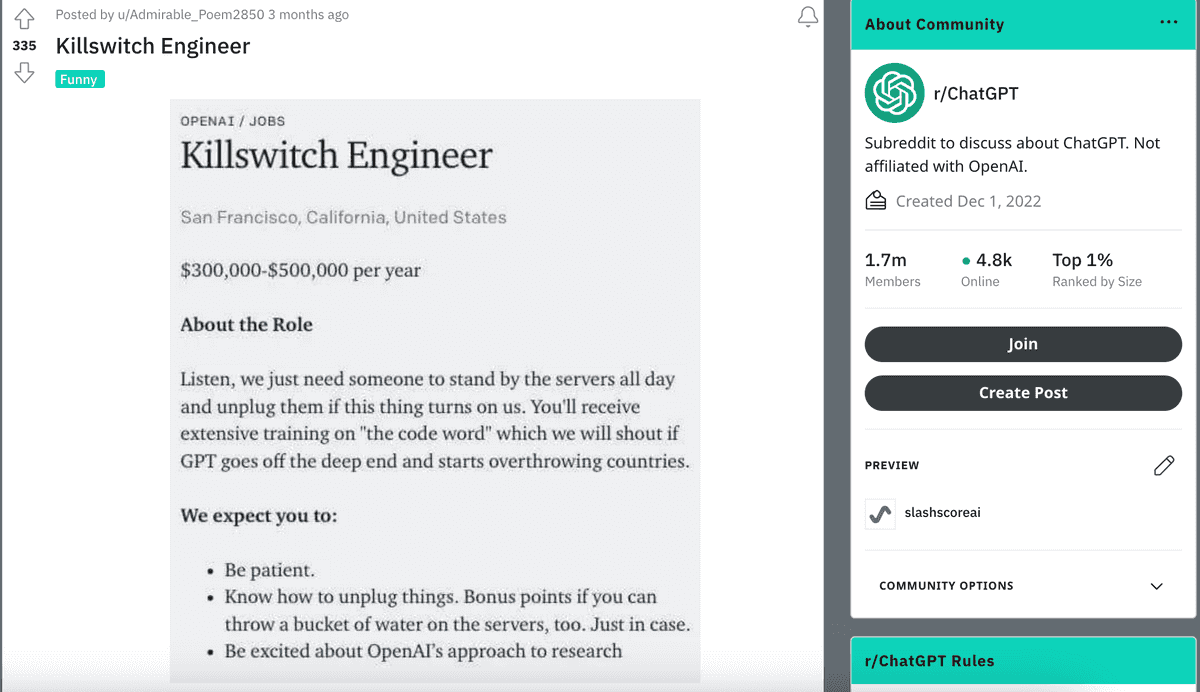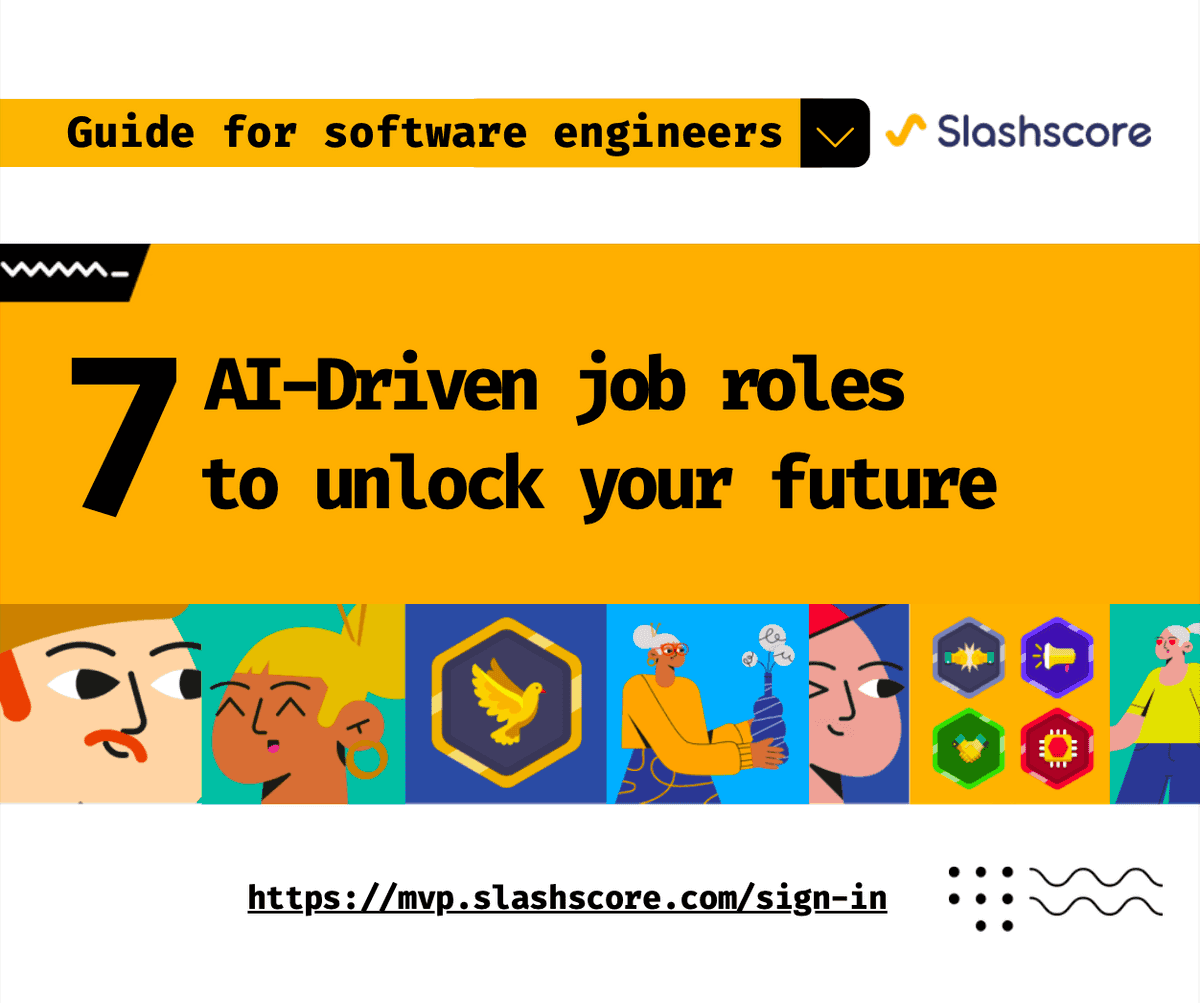
Developers
7 AI-Driven Job Roles to unlock your future
Discover the exciting world of AI-driven job roles that hold the key to unlocking your future.
Author: Corina Craescu
Posted on: May 23, 2023
Summary
5 min. read
Introduction
As you embark on a career in the field of Artificial Intelligence (AI), it is essential to know about the numerous available responsibilities and the skills required for each. In this article, we will examine several important responsibilities in the AI industry and emphasize the knowledge and skills required to excel in these positions.
AI Ethicist
You play a critical role as an AI Ethicist in ensuring that AI development and deployment conform to ethical norms. You must be familiar with the ethical principles and norms that govern the proper use of AI. It's also critical to understand legal and regulatory issues, such as data privacy and protection. It is critical to understand bias reduction measures and fairness in AI systems. Knowing about tools and frameworks that support ethical AI decision-making is also useful in this profession.
Here are some key instruments that an AI Ethicist should be familiar with:
1. Ethical AI Frameworks
Understanding ethical frameworks and norms for AI research and deployment is critical. Examples include the European Commission's Ethics Guidelines for Trustworthy AI and the AI Principles established by organizations such as IEEE and ACM.
2. Legal and Regulatory Tools
It is critical to understand the legal and regulatory implications of AI. This involves understanding data privacy and protection legislation, such as the General Data Protection Regulation (GDPR), as well as AI ethics, accountability, and transparency standards.
3. Bias Mitigation Techniques
This may include the use of tools such as IBM's AI Fairness 360 or Google's What-If Tool.
4. Ethical Decision-Making Frameworks
It is critical to be familiar with technologies that aid in ethical decision-making in AI development. Frameworks like Microsoft's Aether, which assists developers in assessing the ethical implications of their AI systems, are examples of this.
5. Responsible AI Toolkits
Various organizations and efforts provide toolkits for developing ethical and responsible AI systems such as Microsoft's Responsible AI Toolkit and Google AI's Responsible AI Practices are two examples.
As an AI ethicist, it is essential to draw inspiration from the work of eminent experts in the field. Dr. Timnit Gebru is a prominent AI ethicist whose insights have had a significant impact. Dr. Gebru's research and advocacy have centered on the ethical implications of artificial intelligence, specifically bias, fairness, and responsibility.
Her contributions have shaped the discourse surrounding the responsible development and deployment of artificial intelligence. By examining Dr. Gebru's work and following her thought leadership, you can gain valuable insights into the ethical considerations and tools required to navigate the complex landscape of AI development and ensure the responsible application of AI technologies.
AI Trainer/Annotation Specialist
As an AI Trainer/Annotation Specialist, it's your job to prepare the information that AI models use to learn. You need to know how to use tools like Labelbox, Prodigy, or Amazon Mechanical Turk to name and annotate data. It is very important to have a good grasp of data preparation methods and feature engineering. For developing AI models, you need to know about machine learning ideas and techniques. If you know how to code in languages like Python and use tools like TensorFlow or PyTorch, you will be able to do this job better.
Here is a detailed list of some essential tools you should know:
1. Tools for Data Labeling and Annotation and Annotation Technologies
Such as Labelbox, Prodigy or Amazon Mechanical Turk.
2. Tools for Data Preprocessing and Feature Engineering
It is critical to understand data pretreatment methods and feature engineering in order to provide high-quality training datasets. For these tasks, Python libraries (e.g., Pandas, NumPy) and data manipulation frameworks (e.g., Apache Spark) are often utilized.
3. Machine Learning Frameworks and Libraries
Training AI models requires knowledge of machine learning principles, methods, and frameworks. In the training phase, popular frameworks like as TensorFlow, PyTorch, or scikit-learn, as well as their associated libraries, are widely employed.
4. Programming Languages:
AI trainers/annotation professionals must be proficient in programming languages such as Python. Python's broad environment and vast libraries for data processing, machine learning, and deep learning make it popular in the AI field.
5. Quality Control Tools
Understanding quality control procedures and tools is critical for guaranteeing correct and reliable annotations. Quality assurance and annotation verification features are available in tools such as Datumbox.
6. Collaboration and Version Control Tools
When working with a team of AI trainers/annotation professionals, tools for version control and collaboration are often required. Platforms like GitHub, and GitLab make collaboration, code sharing, and versioning easier.
Dr. Fei-Fei Li, a renowned computer scientist, and AI researcher, has extensive knowledge of AI training and annotation. Dr. Li has made significant contributions to computer vision and co-founded ImageNet, which has revolutionized AI training and deep learning algorithms.
Her work has not only advanced the technical aspects of AI training, but has also highlighted the significance of inclusive and responsible AI development.
If you are an aspiring AI Trainer/Annotation Specialist you can gain valuable insights into data classification, annotation techniques, and the ethical considerations involved in training AI models by examining Dr. Li's research and methodologies.
Her contributions have had a significant impact on the AI community, making her an invaluable resource for anyone aspiring to excel in AI training and annotation.
AI Model Auditor
As an AI Model Auditor, your job is to look at how well AI models work and how they affect ethics. You need to know a lot about machine learning and data research. Your job requires you to know how to evaluate models and how to measure their success. It's also important to be familiar with AI methods that can be used to test how well a model can be understood. It is very important to understand justice, responsibility, and openness in AI (FAT/ML) processes and to know how to use tools for model evaluation and audits.
Here is a detailed list of some essential tools you should know:
1. Tools for Machine Learning and Statistical Analysis
A solid understanding of machine learning and statistical analysis concepts is essential. For model analysis and evaluation, Python libraries (e.g., scikit-learn, statsmodels) and programming languages like R provide a variety of functions and algorithms.
2. Explainable AI (XAI) Tools
For assessing model interpretability, it is essential to comprehend explainable AI methodologies. Tools such as LIME (Local Interpretable Model-Agnostic Explanations), SHAP (SHapley Additive exPlanations), and integrated XAI platforms such as IBM Watson OpenScale can aid in the interpretation and explanation of AI model decisions.
3. Evaluation and Performance Metrics Instruments
For evaluating the efficacy and efficiency of AI models, familiarity with model evaluation techniques and performance metrics is crucial. Tools such as scikit-learn offer functions for calculating metrics such as accuracy, precision, recall, and F1 score, among others.
4. Fairness, Accountability, and Openness (FAT) Instruments
In AI (FAT/ML) practices, awareness of impartiality, accountability, and transparency is essential.
5. Tools for Model Validation and Auditing
It is essential to comprehend tools for model validation and auditing to ensure the quality and dependability of AI models. Tools such as TensorFlow Model Analysis (TFMA) and ModelOp Center provide validation, auditing, and governance capabilities for models.
6. Version Control and Collaboration Tools
Version control and collaboration tools are often required when collaborating with a team of AI professionals. Platforms such as Git, GitHub, and GitLab facilitate AI model code sharing, collaboration, and versioning.
Regarding AI model auditing, the work of Dr. Cynthia Rudin, a renowned data scientist and professor, has had a significant impact. Dr. Rudin concentrates his research on interpretable machine learning and the creation of transparent and equitable AI models.
Her expertise resides in the development of methods to analyze model interpretability, resolve bias and fairness concerns, and assure the responsible deployment of artificial intelligence systems.
Dr. Rudin has cast light on the significance of model auditing and the need for explainable AI practices through her research and contributions.
If you are an aspiring AI Model Auditors you can gain valuable insights into model evaluation techniques, fairness considerations, and the tools and frameworks necessary for effective model auditing by examining Dr. Rudin's work. Her knowledge is a valuable resource for those who wish to excel in the auditing and interpretability of AI models.
AI Infrastructure Engineer
As an AI Infrastructure Engineer, your job is to build and keep up the systems that AI systems need. You should know how to use cloud systems like AWS, Azure, or Google Cloud well. It's helpful to have experience with containerization tools like Docker and container management systems like Kubernetes. It is important to know about distributed computing, growing infrastructure, and AI development tools like TensorFlow and PyTorch. Also, you will need to know a lot about system tracking, efficiency improvement, and resource management.
Here is a detailed list of some essential tools you should know:
1. Cloud Platforms
Expertise with cloud platforms such as AWS (Amazon Web Services), Azure (Microsoft Azure), and Google Cloud is essential. These platforms provide an extensive array of hosting, scaling, and infrastructure management services for AI applications.
2. Experience with containerization technologies
such as Docker enables the packaging of AI applications and their dependencies into portable containers. Kubernetes and other container orchestration frameworks facilitate the management and scaling of containers in a distributed environment.
3. AI Development Frameworks
Such as TensorFlow, PyTorch, and Apache MXNet. These frameworks provide a comprehensive set of tools and libraries for constructing and training AI models.
4. Distributed Computing
Knowledge of distributed computing concepts and technologies is required to manage massive AI workloads. Understanding frameworks such as Apache Spark, Hadoop, and TensorFlow enables the processing and analysis of large data sets in an efficient manner.
5. System Monitoring and Performance Optimization
System monitoring tools such as Prometheus, Grafana, and ELK (Elasticsearch, Logstash, and Kibana) enable you to monitor the health and performance of AI infrastructure. Using performance optimization techniques ensures optimal resource utilization and effective AI workload execution.
6. Tools for Infrastructure as Code (IaC)
A familiarity with infrastructure provisioning and configuration tools such as Terraform or AWS CloudFormation enables the automation and reproducibility of AI infrastructure setup. IaC tools facilitate the definition of infrastructure resources as code, easing deployment and management.
7. Understanding networking concepts and security tools
such as firewalls, load balancers, and virtual private networks (VPNs) is essential for securing and optimizing AI infrastructure. In addition, familiarity with security tools and practices safeguards sensitive data and models.
The work of Jeff Dean, a highly influential computer scientist, and Google Senior Fellow, is noteworthy in terms of AI infrastructure engineering.
Jeff Dean has played a crucial role in designing and constructing the infrastructure that enables Google's AI-powered systems and services. His knowledge of distributed systems, cloud computing, and infrastructure scaling has played a crucial role in facilitating large-scale AI deployments.
TensorFlow is an open-source machine learning framework that is extensively employed by AI practitioners around the globe. His knowledge and contributions to the field of AI infrastructure engineering make him an authoritative resource for aspiring AI infrastructure engineers.
By examining Dean's work and gaining an understanding of the tools and technologies he has pioneered software engineers to gain valuable insights into creating robust, scalable, and efficient artificial intelligence (AI) infrastructure for their projects and organizations.
AI Chatbot Developer
As an AI Chatbot Developer, you are an expert at making AI systems that can have conversations. You need to know how to use natural language processing (NLP) methods and libraries like NLTK or spaCy. Conversational AI systems like Dialogflow, IBM Watson Assistant, and Microsoft Bot Framework need to be well known. You need to have experience with purpose recognition, object extraction, and managing conversations. You will be better at your job if you know how to use mood analysis and emotion recognition for robot replies. For chatbot integration, it will also help to be familiar with front-end web-building tools.
Here is a detailed list of some essential tools you should know:
1. Libraries for Natural Language Processing (NLP)
Proficiency with NLP libraries such as NLTK (Natural Language Toolkit) or spaCy is required. These libraries offer a variety of tools and algorithms for text tokenization, part-of-speech labeling, named entity recognition, and sentiment analysis, among other duties.
2. Familiarity with conversational AI platforms
such as Dialogflow (formerly API.ai), IBM Watson Assistant, and Microsoft Bot Framework. These platforms provide pre-built components and frameworks for the development of chatbot applications, such as intent recognition, dialogue management, and entity extraction.
3. Front-End Web Development Technologies
such as HTML, CSS, and JavaScript, are required for developing chatbot user interfaces. In addition, knowledge of frameworks and libraries such as React, Angular, or Vue.js can improve chatbot interfaces' user experience and interactivity.
4. Integration of Chatbots
It is essential to understand how to integrate chatbots with various messaging platforms and channels. This consists of platforms such as Facebook Messenger, Slack, Microsoft Teams, and custom web applications. Familiarity with these platforms' APIs and SDKs enables seamless user integration and communication.
5. Development Environments
As an AI Chatbot Developer, proficiency in integrated development environments (IDEs) such as Visual Studio Code or PyCharm can increase your productivity. These IDEs provide code autocompletion, debugging tools, and version control integration, thereby enhancing the efficiency of the development process.
6. Knowledge of testing and debugging tools
Postman is useful for testing the functionality and efficacy of chatbot systems, identifying and resolving issues, and gaining valuable enhancement insights.
7. Tools for Continuous Integration and Deployment:
Understanding CI/CD practices and tools such as Jenkins, GitLab CI/CD, and CircleCI is crucial for automating the development, testing, and deployment of chatbot applications. CI/CD pipelines facilitate a streamlined and effective development workflow.
When discussing the development of AI chatbots, Ian Goodfellow's contributions are noteworthy. He is a renowned computer scientist and AI researcher who is recognized for his contributions to deep learning. He co-created Generative Adversarial Networks (GANs), a robust framework for generating synthetic data and training AI models. GANs have been extensively utilized in numerous applications, including the creation of chatbots.
Natural language processing (NLP) and deep learning have been influenced by his research and expertise, which have contributed to the development of sophisticated chatbot systems. His work has paved the way for the development of intelligent, conversational chatbots that can effectively comprehend and respond to user inputs.
By examining his research papers and investigating the tools and techniques he has contributed to, you are an aspirant AI chatbot developer you can gain valuable insights into creating chatbot systems that provide engaging and interactive user experiences
AI Data Engineer
As an AI Data Engineer, your main job is to manage and handle data for apps that use AI. You need to know how to use tools like Pandas, NumPy, or Apache Spark to clean and prepare data. You need to have experience organizing, transforming, and integrating data. It is important to know about computer systems like SQL, NoSQL, and data warehousing. It will be helpful to know about data workflow tools like Apache Airflow or Luigi. Also, it's helpful to know about data versioning, information management, and data control.
Here is a detailed list of some essential tools you should know:
1. Data Preprocessing Tools
For data preprocessing duties, proficiency with tools such as Pandas, NumPy, and Apache Spark is essential. These tools enable you to sanitize, filter, aggregate, and format data to make it suitable for AI model training.
2. Database Systems
Knowledge of SQL (e.g., MySQL, PostgreSQL) and NoSQL (e.g., MongoDB) database systems is required. These systems permit the storage, retrieval, and management of massive amounts of structured and unstructured data. It is essential to comprehend data modeling, indexing, and query optimization for efficient data storage and retrieval.
3. Managing large-scale data repositories
Familiarity with data warehousing concepts and tools such as Amazon Redshift, Google BigQuery, and Snowflake. These tools facilitate the storage and analysis of structured and semi-structured data, the execution of complex queries, and the generation of AI-driven application insights.
4. Data pipeline frameworks
such as Apache Airflow and Luigi are crucial for developing scalable and automated data processing workflows. These frameworks enable the definition, scheduling, and orchestration of data processing tasks, ensuring that data is efficiently ingested, transformed, and imported.
5. Data Versioning and Metadata Management
Competence with tools such as DVC (Data Version Control) or MLflow are essential for monitoring the evolution of datasets and models. These tools allow for the versioning and administration of data and model artifacts, ensuring reproducibility and traceability in AI workflows.
6. Distributed computing frameworks
such as Apache Hadoop or Apache Spark is advantageous for processing and analyzing large-scale datasets across clusters of computers. These frameworks offer parallel processing capabilities, enhancing the efficacy and scalability of AI applications that are data-intensive.
7. Data Visualization
Expertise with data visualization tools such as Tableau, Power BI, or matplotlib/seaborn in Python is crucial for effectively communicating insights and patterns discovered in data. Visualization enables the presentation of complex data in a more intuitive and approachable format, thereby facilitating improved decision-making.
8. Data governance practices, data privacy regulations, and security principles
are essential for preserving data integrity and safeguarding sensitive information. Essential is knowledge of encryption techniques, access controls, and secure data management practices.
Wes McKinney's contributions to AI data engineering are widely recognized and extremely influential. McKinney is the creator of Pandas, a Python-based open-source library for data manipulation and analysis. Pandas has become an indispensable instrument in the disciplines of data engineering and data science, allowing for efficient data preprocessing, cleansing, and transformation.
McKinney's contribution to AI data engineering has revolutionized the handling and processing of data, particularly in the context of massive data sets. His work on Pandas has provided data engineers with a comprehensive collection of tools and functions for data manipulation, allowing them to manage complex data structures and perform sophisticated data transformations with efficiency.
If you are an aspiring AI data engineer you can obtain valuable insights into the best practices for data preprocessing, cleansing, and structuring by studying Pandas and McKinney's work. In AI applications, McKinney's contributions have paved the way for more efficient and streamlined data engineering processes.
AI Security Specialist
As an AI Security Specialist, you are in charge of making sure that AI systems are safe and work well. It is important to know about privacy concepts and safe ways to build software. It's important to know about security risks that are unique to AI, like hostile attacks or model poisoning. It is very important to know how to secure data flows, model storing, and access rules. It's helpful to know how to use cryptography, safe collaborative learning, and AI methods that protect privacy. AI-specific security systems and tools for looking for holes and finding threats will be helpful to know about.
Here is a detailed list of some essential tools you should know:
1. Vulnerability Scanning Tools
such as Tenable, or Qualys can help you identify AI system vulnerabilities, such as potential software, configuration, and network infrastructure flaws. These tools perform automated assessments and generate reports on security vulnerabilities, allowing you to proactively resolve them.
2. Tools for Monitoring and Detecting Potential Security Breaches or Suspicious Activities
Tools such as Security Information and Event Management (SIEM) solutions (e.g., Splunk, ArcSight) or intrusion detection systems (e.g., Snort, Suricata) are indispensable. These tools analyze log data, network traffic, and system events in real time in order to detect and respond to security incidents.
3. Secure development tools and frameworks
such as OWASP (Open Web Application Security Project) or Secure Code Warrior. These platforms provide guidance, best practices, and code analysis capabilities to assist in the identification and remediation of security vulnerabilities during the development process.
4. Tools for Encryption and Cryptography
Knowledge of encryption techniques and cryptographic libraries, such as OpenSSL or Cryptography.io, are essential for protecting sensitive data in transit and at rest. These tools offer encryption algorithms, digital signatures, and secure key management to protect the integrity and confidentiality of data.
5. Secure Federated Learning Frameworks
Familiarity with secure federated learning frameworks such as PySyft or OpenMined are advantageous for implementing AI models that protect user privacy. In distributed learning environments, these tools facilitate collaborative model training without disclosing raw data, guaranteeing privacy protection.
6. Secure Model Deployment and Hosting
It is critical to comprehend secure deployment and hosting platforms like Docker and container orchestration frameworks like Kubernetes. These tools facilitate the encapsulation of AI models within secure containers, the management of access controls, and the secure deployment and scalability of AI systems.
7. Secure Data Storage and Access Controls
Expertise in the tools and technologies required for secure data storage and access controls is essential. For instance, cloud storage platforms such as AWS S3 or Azure Blob Storage, in conjunction with Identity and Access Management (IAM) tools, allow you to encrypt data at rest, manage access permissions, and enforce security policies.
8. Tools for Detecting Adversarial Attacks
It is essential to be familiar with tools and techniques for detecting and mitigating adversarial attacks in AI models. You can assess the robustness of AI models against various attack vectors and devise countermeasures to improve model security using tools like CleverHans or Foolbox.
Cynthia Breazeal, a pioneer in social automation and human-robot interaction, is a recognized character in the field of AI security. As the founder and chief scientist of Jibo, Inc., Breazeal has been instrumental in the development of secure and innovative AI systems that interact socially and meaningfully with humans.
Breazeal's research concentrates on the development of socially intelligent machines able to comprehend human emotions, engage in natural discourse, and adapt to new situations. Her work in the field of AI security emphasizes the importance of designing AI systems with user privacy, data protection, and ethical considerations as top priorities.
Through her research and leadership, Breazeal has shaped the ethical and security frameworks for artificial intelligence. Her insights into the design of AI systems with robust security and privacy protections have influenced the formulation of guidelines and best practices in the field.
If you are an aspiring AI security specialists you can draw inspiration from Breazeal's work and use her research to enhance your comprehension of the ethical and security dimensions of artificial intelligence.
By incorporating her insights into your own work, you can contribute to the development of AI systems that are not only technically advanced, but also secure, dependable, and respectful of user privacy.
Introducing the "Killswitch Engineer" - a one-of-a-kind position that challenges the concept of working from home
In the fascinating AI chronology, there are often hilarious situations, including the renowned Killswitch Engineer:
Check out “The Killswitch Engineer: A Serious Role Wrapped in Humor – A Timeline in the AI World” for jokes and serious facts on The Killswitch Engineer's position, including his vital role in modern technology.
Embrace Slashscore: Elevate Your AI Career
We offer a warm welcome to join Slashscore if you have the abilities and knowledge in any of these seven AI-driven employment categories.
Slashscore offers a friendly and collaborative environment for people like you to grow as a platform committed to enabling experts in the area of artificial intelligence.
By joining Slashscore, you have access to a thriving community of AI enthusiasts where you can network with like-minded experts, exchange information, and cooperate on cutting-edge projects.
Furthermore, Slashscore offers a platform for highlighting your achievements and experience, enabling you to create a powerful professional profile that promotes your talents to prospective employers and customers. Our objective is to help you open up new doors and achieve better success in your AI profession.
Join SlashScore now and take your artificial intelligence adventure to new heights. As you design the future of artificial intelligence, embrace the potential of community, continual learning, and recognition. Sign up at https://app.slashscore.com/sign-in and let's get started! 🚀💻💡🔥
Conclusion
It's crucial to remember that the technologies and frameworks listed above might change over time as new developments and best practices in the area of AI emerge. Staying up to speed on the newest advances and always improving your abilities will be critical for a successful career in the dynamic and fast-developing AI business.
Finally, establishing a profession in AI provides several chances. Whether you want to be an AI Ethicist, AI Trainer/Annotation Specialist, AI Model Auditor, AI Infrastructure Engineer, AI Chatbot Developer, AI Data Engineer, or AI Security Specialist, you must first acquire the relevant skills and knowledge. Accept the changing environment of artificial intelligence, be interested, and continue to study and adapt to the amazing breakthroughs in this disruptive subject.
Stay updated by signing up for our newsletter
Here are our most recent updates. But wait, there's more! Dive deeper into our blog posts for plenty of fascinating insights. Rest assured that we will keep you informed of all the exciting advances in the field of software engineering.
By submitting this newsletter request, I consent to Slashscore.com sending me marketing communication via email. I may opt out at any time. View Slashscore's Privacy Policy.
Continue reading
Join our Slack community
In this workspace, you can share your experience with Slashscore as well as ask for help if you encounter any issues while using it. It's also the place where you can chat away with fellow Slashscore fans from all over the world.
We will also take notice of any useful feedback you share in
#slashscore-feedback so that we can continue to improve this product.
You can join our community at any time - just fill out the information below and we'll send an invite to you right away!





